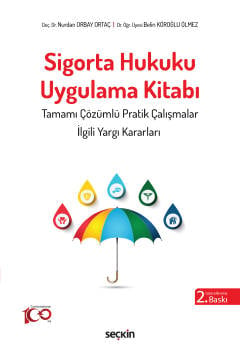>
Hukuk Kitapları>
Ticaret Hukuku>
Sigorta Hukuku>
Impacts of The "Pay to Be Paid" Rule On P&I Insurance under Compulsory Insurance and Direct Action

Impacts of The "Pay to Be Paid" Rule On P&I Insurance under Compulsory Insurance and Direct Action
1. Baskı,
Mart 2024
Kitabın Detayları
Dili:
İngilizce
Ebat:
16x24
Sayfa Sayısı:
152
Kitabın Fiyatı:
230,00₺
Temin süresi 2-3 gündür.
Kitabın Açıklaması
Since the dawn of civilisation onwards, and especially following marine disasters, marine risks have become more complicated, and so has the issue of increasing third-party liabilities of shipowners. İt was, therefore, noticed that there was a need for a legal regulation in that regard, which resulted in the adoption of international conventions and the implementation thereof into national laws, in order to protect third parties to the contract of P&l insurance, weaker ones vis-â-vis the strong clubs and shipowners.
First and foremost, providing financial security, which is usually provided by P&l clubs in the form of an insurance contract in practice, for the liability of shipowners under those conventions was imposed on them. That being the case, third parties might remain out of pocket provided that shipowners are insolvent. Furthermore, there is an absence of a contractual relationship between clubs and third parties due to the principle of inter partes,more precisely, privity of contract, i.e., claimants cannot sue clubs. Thus, in addition to compulsory insurance, the right of direct action was granted to third parties for them to proceed against clubs, which are financially stronger than shipowners and, thanks to mutuality underpinning the basis of P&l clubs, other insurers.
Neither making insurance compulsory nor granting the right of direct action properly solves this problem having regard to the fact that clubs might rely on the defence of "pay to be paid", in accordance with which the member shall make the necessary payments he is liable for to be reimbursed by his club, also in direct actions against third parties. For that very reason, "pay to be paid" has been waived in the specific fields of maritime law. From a contrario aspect, it is stili retained in some other fields. The ideal solution should be to establish a direct connection between clubs and claimants, where clubs cannot rely on such defence. Even then, the extent should be determined in respect of which claims and to what extent they should be protected thus and so. İn sum, claims covered under P&l insurance was analysed to that end.
Kitabın Konu Başlıkları
An Overview Of Marine Insurance
History Of P&I Insurance
Role and Function Of The "Pay To Be Paid" Rule Within The Context Of The Distinctive Features Of P&I Insurance
Significance Of Compulsory Insurance and Direct Action and The Impacts Of The "Pay To Be Paid" Rule Thereon
Concluding Remarks
Academic Sources
Kitapla İlgili Kategoriler
Kitabın İçindekileri
TABLE OF CONTENTS
ACKNOWLEDGEMENT
7
ÖZET
9
ABSTRACT
11
TABLE OF CONTENTS
13
ABBREVIATIONS
17
I. INTRODUCTION
21
A. SUBJECT MATTER, AIM AND QUESTIONS
21
1. Role of Insurance
21
2. Role of Marine Insurance
22
3. P&I Insurance and the Subject Matter and Aim
23
4. Questions Raised
25
B. SCOPE AND STRUCTURE
27
C. APPROACH AND METHODOLOGY
28
II. AN OVERVIEW OF MARINE INSURANCE
31
A. BRIEF HISTORY
31
B. TYPES OF MARINE INSURANCE OF WHICH P&I IS A PART
33
1. Marine Cargo Insurance
33
2. Hull and Machinery Insurance (H&M)
34
3. Protection and Indemnity Insurance (P&I)
35
a. P&I Defined
35
b. Claims Covered
37
c. Legal Framework
44
i. Statutory Framework
44
ii. Contractual Framework
45
aa. In Terms of Insurance Law
45
bb. In Terms of Law of Obligations
47
4. Other Types of Marine Insurance
51
III. HISTORY OF P&I INSURANCE
53
A. EVOLUTIONARY BACKGROUND
53
1. Impacts of the Bubble Act 1720 and the Period Theretofore
53
2. Decline of the Hull Clubs and Increasing Liabilities of
Shipowners
55
3. From Protection Plus Indemnity Onwards
58
4. Reinsurance and the Pooling System
59
5. Moving to Offshore Countries
61
B. PROVIDERS AS OF TODAY
62
1. P&I Clubs
62
a. Legal Structure
62
b. Constitution and Management
63
c. Correspondents and Brokers
64
d. Club Membership
66
2. Traditional Insurance Companies
68
IV. ROLE AND FUNCTION OF THE “PAY TO BE PAID” RULE WITHIN THE
CONTEXT OF THE DISTINCTIVE FEATURES OF P&I INSURANCE
71
A. THE “PAY TO BE PAID” RULE
71
1. The Condition Precedent
71
2. Conditions and Measure of Indemnity
73
3. Doctrine of Subrogation in the Policy
75
a. Legal Doctrines Reinforcing the Indemnity Principle
75
b. Subrogation in Terms of P&I Insurance
76
i. On the Part of Clubs
76
ii. On the Part of Third–Party Claimants
78
4. Problems Arising out of Its Application
79
a. Establishment and the Ensuing Problems
79
b. Erosion Towards the 21th Century
81
c. The Current Situation
82
B. PRINCIPLE OF MUTUALITY
83
1. Role and Function in the Policy
83
2. Significance on the Part of Third–Party Claimants
86
C. NON–PROFIT–MAKING BASE
87
D. CLAIMS HANDLING
89
V. SIGNIFICANCE OF COMPULSORY INSURANCE AND DIRECT ACTION
AND THE IMPACTS OF THE “PAY TO BE PAID” RULE THEREON
91
A. THREE–TIERED PROTECTION
91
1. Compulsory Insurance
91
2. Direct Action
93
3. Waiver of “Pay to Be Paid”
93
B. LEGAL FRAMEWORK
95
1. Under International Law
95
a. CLC 1992, FUND 1992, and the Protocol of 2003
95
b. BUNKERS 2001
100
c. WRC 2007
102
d. HNS 2010
104
e. PAL 2002
106
f. IMO Guidelines
109
g. MLC 2006 and the Amendments of 2014
111
2. Under Supranational Law
115
3. Under National Laws
115
a. English Law
115
b. Scandinavian Law
118
c. American Law
119
d. Turkish Law
121
C. PERSPECTIVE OF CLUBS
123
VI. CONCLUDING REMARKS
127
VII. ACADEMIC SOURCES
135
A. PRIMARY SOURCES
135
1. Convention Based Regimes
135
2. National Regimes
137
a. English Legislation
137
b. Scandinavian Legislation
138
c. American Legislation
138
d. Turkish Legislation
138
B. SECONDARY SOURCES
139
1. Doctrine
139
a. Books
139
b. Articles
140
c. Reports
143
d. Theses
144
2. Court Decisions
145
3. Other Written Sources
146
a. Club Rules
146
b. Standard Clauses
146
c. Guidelines, Resolutions, and Directives
147
d. Others
148
4. Websites
148
Kitabın Fiyatı:
230,00₺
Temin süresi 2-3 gündür.
Hakkımızda
|
Uluslararası Yayınevi Belgesi|
2023 Kaynakça Dokümanı|
Kişisel Verilerin Korunması |
Üyelik|
Siparişlerim|
İletişim


